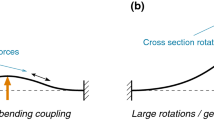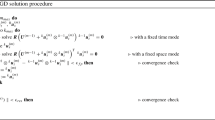Abstract
The solution of nonlinear structural problems by means of a space–time model order reduction approach is investigated. The main target is the prediction of the long-term response while reducing both the computation time and the storage requirements considerably. A nonstandard discretization approach is used which treats the internal degrees of freedom as additional unknowns. The resulting nonlinear problem is formulated in a variational setting. The proposed reduced basis represents the behavior of the structure in a complete time interval, e.g. during one load cycle (for cyclic processes). The reduced variables are obtained by a projection of the time-local stationary conditions onto appropriate test functions defined in space–time. This leads to a low-dimensional nonlinear system of equations. Details regarding the theoretical derivation, the discretization and the numerical treatment of the nonlinearity are presented. In the numerical examples the reduced model is compared to FEM reference solutions. Different choices for the test functions are discussed and the postprocessing abilities offered by the reduced model are illustrated.
















Similar content being viewed by others
References
Ammar A, Mokdad B, Chinesta F, Keunings R (2006) A new family of solvers for some classes of multidimensional partial differential equations encountered in kinetic theory modeling of complex fluids. J Nonnewton Fluid Mech 139(3):153–176
Ammar A, Mokdad B, Chinesta F, Keunings R (2007) A new family of solvers for some classes of multidimensional partial differential equations encountered in kinetic theory modelling of complex fluids: part II: transient simulation using space–time separated representations. J Nonnewton Fluid Mech 144(2–3):98–121
Argyris J, Scharpf D (1969) Finite elements in time and space. Nucl Eng Des 10(4):456–464
Benner P, Gugercin S, Willcox K (2015) A survey of projection-based model reduction methods for parametric dynamical systems. SIAM 57:483–531
Boisse P, Bussy P, Ladeveze P (1990) A new approach in non-linear mechanics: the large time increment method. Int J Numer Methods Eng 29(3):647–663
Capurso M, Maier G (1970) Incremental elastoplastic analysis and quadratic optimization. Meccanica 5:107–116
Chinesta F, Ladevèze P, Cueto E (2011) A short review on model order reduction based on proper generalized decomposition. Arch Comput Methods Eng 18(4):395
Christensen R (1980) A nonlinear theory of viscoelasticity for application to elastomers. J Appl Mech 47(4):762–768
Comi C, Perego U (1995) A unified approach for variationally consistent finite elements in elastoplasticity. Comput Methods Appl Mech Eng 121(1):323–344
Fried I (1969) Finite-element analysis of time-dependent phenomena. AIAA J 7(6):1170–1173
Fritzen F, Böhlke T (2010) Three-dimensional finite element implementation of the nonuniform transformation field analysis. Int J Numer Methods Eng 84(7):803–829
Fritzen F, Böhlke T (2013) Reduced basis homogenization of viscoelastic composites. Compos Sci Technol 76:84–91
Fritzen F, Leuschner M (2013) Reduced basis hybrid computational homogenization based on a mixed incremental formulation. Comput Methods Appl Mech Eng 260:143–154
Fritzen F, Hodapp M, Leuschner M (2014) GPU accelerated computational homogenization based on a variational approach in a reduced basis framework. Comput Methods Appl Mech Eng 278:186–217
Germain P, Nguyen QS, Suquet P (1983) Continuum thermodynamics. J Appl Mech 50(4b):1010–1020
Guennouni T (1988) Sur une méthode de calcul de structures soumises à des chargements cycliques: l’homogénéisation en temps. RAIRO Model Math Anal Numer 22(3):417–455
Haasdonk B (2017) Reduced basis methods for parametrized PDEs—a tutorial introduction for stationary and instationary problems. In: Model reduction and approximation: theory and algorithms, vol 15. p 65
Hackl K (1996) Generalized standard media and variational principles in classical and finite strain elastoplasticity. J Mech Phys Solids 45(5):667–688
Halphen B, Nguyen Q (1975) Sur les Matériaux Standard Généralisés. J Mec 1(14):39–63
Haouala S, Doghri I (2015) Modeling and algorithms for two-scale time homogenization of viscoelastic–viscoplastic solids under large numbers of cycles. Int J Plast 70:98–125
Holzapfe GA, Simo JC (1996) A new viscoelastic constitutive model for continuous media at finite thermomechanical changes. Int J Solids Struct 33(20–22):3019–3034
Karhunen K (1947) Über lineare Methoden in der Wahrscheinlichkeitsrechnung. Annales Academiae scientiarum Fennicae. Series A. 1, Mathematica-physica. University of Helsinki, Helsinki
Ladevèze P (1989) The large time incmethod for the analysis of structures with non-linear behavior described by internal variables. C R Acad Sci II 309(11):1095–1099
Ladevèze P (1999) Nonlinear computational structural mechanics—new approaches and non-incremental methods of calculation. Springer, New York
Ladevèze P, Passieux JC (2010) The LATIN multiscale computational method and the proper generalized decomposition. Comput Methods Appl Mech Eng 199(21–22):1287–1296. doi:10.1016/j.cma.2009.06.023 (Multiscale models and mathematical aspects in solid and fluid mechanics)
Lai J, Findley WN (1968) Stress relaxation of nonlinear viscoelastic material under uniaxial strain. Trans Soc Rheol 12(2):259–280
Lakes RS (1998) Viscoelastic solids, vol 9. CRC press, Boca Raton
Leuschner M, Fritzen F (2017) Reduced order homogenization for viscoplastic composite materials including dissipative imperfect interfaces. Mech Mater 104:121–138. https://authors.elsevier.com/a/1U21Yc7qwIgHl
Maier G (1968) Quadratic programming and theory of elastic-perfectly plastic structures. Meccanica 3:265–273
Michel J, Suquet P (2003) Nonuniform transformation field analysis. Int J Solids Struct 40:6937–6955
Michel J, Suquet P (2004) Computational analysis of nonlinear composite structures using the nonuniform transformation field analysis. Comput Methods Appl Mech Eng 193:5477–5502
Miehe C (2002) Strain-driven homogenization of inelastic microstructures and composites based on an incremental variational formulation. J Numer Methods Eng 55:1285–1322
Miehe C (2011) A multi-field incremental variational framework for gradient-extended standard dissipative solids. J Mech Phys Solids 59(4):898–923
Néron D, Boucard PA, Relun N (2015) Time-space PGD for the rapid solution of 3D nonlinear parametrized problems in the many-query context. Int J Numer Methods Eng 103(4):275–292
Ortiz M, Stainier L (1999) The variational formulation of viscoplastic constitutive updates. Comput Methods Appl Mech Eng 171:419–444
Perić D (1993) On a class of constitutive equations in viscoplasticity: formulation and computational issues. Int J Numer Methods Eng 36(8):1365–1393
Pipkin A, Rogers T (1968) A non-linear integral representation for viscoelastic behaviour. J Mech Phys Solids 16(1):59–72
Relun N, Néron D, Boucard PA (2013) A model reduction technique based on the PGD for elastic–viscoplastic computational analysis. Comput Mech 51(1):83–92
Schapery RA (1969) On the characterization of nonlinear viscoelastic materials. Polym Eng Sci 9(4):295–310
Schüler T, Manke R, Jänicke R, Radenberg M, Steeb H (2013) Multi-scale modelling of elastic/viscoelastic compounds. ZAMM J Appl Math Mech 93(2–3):126–137
Simo J, Honein T (1990) Variational formulation, discrete conservation laws, and path-domain independent integrals for elasto-viscoplasticity. Trans ASME 57:488–497
Simo J, Hughes TJR (2000) Computational inelasticity, corr. 2. print edn. Springer, Berlin
Touati D, Cederbaum G (1997) Stress relaxation of nonlinear thermoviscoelastic materials predicted from known creep. Mech Time Depend Mater 1(3):321–330
Yu Q, Fish J (2002) Temporal homogenization of viscoelastic and viscoplastic solids subjected to locally periodic loading. Comput Mech 29(3):199–211
Zerbe P, Schneider B, Moosbrugger E, Kaliske M (2015) Thermoplastics under long-term loading: experiments and viscoelastic-viscoplastic modeling. PAMM 15(1):375–376
Zerbe P, Schneider B, Kaliske M (2016) Viscoelastic–viscoplastic-damage modeling of thermoplastics under long-term cyclic loading. PAMM 16(1):413–414
Zhang R, Wen L, Naboulsi S, Eason T, Vasudevan VK, Qian D (2016) Accelerated multiscale space–time finite element simulation and application to high cycle fatigue life prediction. Comput Mech 58(2):329–349
Acknowledgements
This work was effected by the Emmy-Noether-Group EMMA supported through Grant DFG-FR2702/6 within the Emmy-Noether program of the Deutsche Forschungsgemeinschaft (DFG). The authors gratefully acknowledge the financial and personal support of the DFG. The authors acknowledge the input of the anonymous reviewers that helped in the completion of the manuscript.
Funding
This study was funded by Deutsche Forschungsgemeinschaft (DFG) (Grant DFG-FR2702/6)
Author information
Authors and Affiliations
Corresponding author
Ethics declarations
Conflict of interest
The authors declare that they have no conflict of interest.
Rights and permissions
About this article
Cite this article
Fritzen, F., Hassani, M. Space–time model order reduction for nonlinear viscoelastic systems subjected to long-term loading. Meccanica 53, 1333–1355 (2018). https://doi.org/10.1007/s11012-017-0734-x
Received:
Accepted:
Published:
Issue Date:
DOI: https://doi.org/10.1007/s11012-017-0734-x




